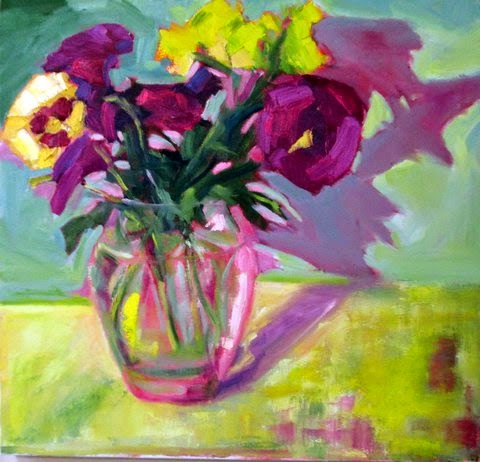 |
| The Astronomer, Johannes Vermeer |
 |
| A Lady Writing, Johannes Vermeer |
The two small paintings above were hung at either end of a short freestanding wall in the middle of a large gallery at the beginning of this absorbing show at the Museum of Fine Arts in Boston. I was there with a friend on a Tuesday, and there were few people in attendance, so I was free to spend a long time with these amazing works. I went back after seeing the whole show and looked again.
I had seen both paintings before twenty years ago at the groundbreaking Vermeer exhibition at the National Gallery of Art in Washington. I remember large crowds swarming around the small, intimate paintings (35 of them!) and feeling the frustration of trying to see, see the detail and delicate values, the paint quality and feel from behind the backs of other viewers. What a treat to see these two again and be able stand and really look. Such control Vermeer had in the value modulations, the edges-some lost, some sharp- and the color! The color stood out from the rest of the masterworks assembled around the Gund Gallery rooms. Vermeer used strong areas of clear color where most of the other works relied on earth tones with browns and greens predominant. The sense of light, controlled light, as a living presence in the paintings. In the 20 years since I last observed these paintings, I have become a different painter with different concerns and interests. I was struck by these paintings in a way I never could have been in 1995.
Well, if you can tear yourself away from the Vermeers, there are many other wonders in the show, including a large Frans Hals group portrait, "Regents of the St. Elizabeth Hospital of Haarlem" with an imposing size and wonderful brushwork. The hands move you around the canvas and are a marvel of grace. It's time for a Frans Hals exhibition, don't you think?
 |
| Frans Hals "Regents of the St. Elizabeth Hospital" |
There are three Rembrandt portraits, but they were not too exciting to me, they felt like early works and didn't have the wonderful humanity of many of his portraits. Not very many landscapes, and no still lifes, I assume they did not fit the theme of the show.
My friend and I stood for awhile disecting this Ter Borch painting of a milkmaid at work in a barn, which is small and incredibly atmospheric with that large dark area entirely taking up the top half of the canvas. The cow at the left is looking at the viewer with a quizzical expression. Beautiful values and edges here, too.
 |
| Gerad Ter Borch, "De Koestal" |
And one more, this elegant De Hooch with lots of subtle detail and fine color which you can't really see in this jpg. Which brings me to the real joy of this show, seeing these works from the 17th century as they are best seen, up close and personal. Nothing beats that.
 |
Pieter de Hooch, " The Courtyard of a House in Delft"
|
Class Distinctions- Dutch Paintings in the age of Rembrandt and Vermeer at the MFA is on view until January 18th.







Comments
Post a Comment